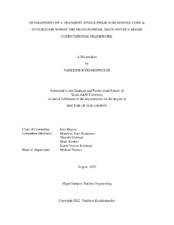| dc.description.abstract | This work details the development of a novel subchannel code within the MOOSE computational framework. MOOSE is a Multi-physics Object Oriented Simulation Environment, a parallel computational framework targeted at the solution of systems of coupled, nonlinear partial differential equations (PDEs), that often arise in the simulation of nuclear processes. As such it includes codes/modules able to solve the multiple complex physics that describe a nuclear reactor, under normal operation conditions or accidents. This includes thermal-hydraulics, fuel performance, neutronics etc.
A MOOSE-based subchannel code is a new effort. This capability extends the area of impact for the fleet of INL developed codes based on the MOOSE framework. The advantage over other subchannel codes is that it is based on the MOOSE framework which means that the code naturally fits into the environment of all other codes and can be easily coupled to them. A subchannel code is a thermal-hydraulics code that solves for flow distribution, temperature, enthalpy, pressure, fluid-properties etc. inside the nuclear-reactor core. Thermal-hydraulic analysis of a nuclear reactor core is mainly performed using the subchannel type of codes to estimate the various thermal-hydraulic safety margins and the various quantities of interest. The safety margins and the operating power limits of the nuclear reactor core under different conditions, i.e., system pressure, coolant inlet temperature, coolant flow rate, thermal power, and its distributions are considered as the key parameters for subchannel analysis.
In this work we present the derivation of the subchannel equations for a single-phase fluid. We proceed with the description of the algorithm that is used to solve these equations. We verify the friction model and the turbulent mixing model. We calibrate the turbulent modeling parameters for momentum mixing and enthalpy mixing, CT, β. We validate the code using experimental results. We describe how this code was implemented within MOOSE and last we present how this code can be coupled to the BISON fuel performance code. | |


